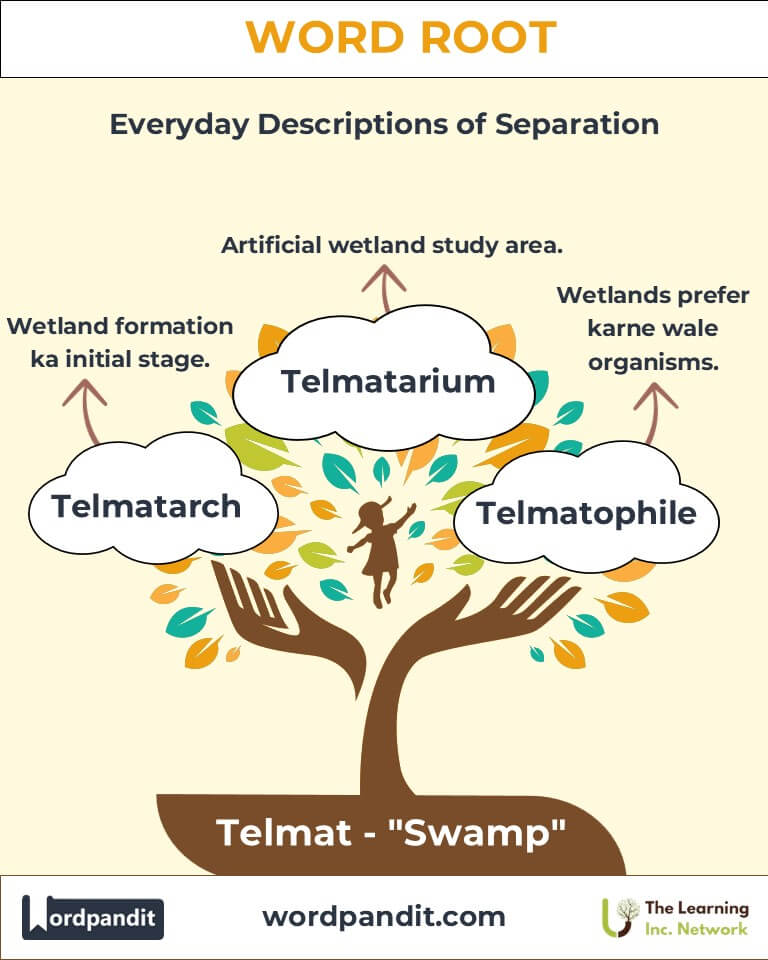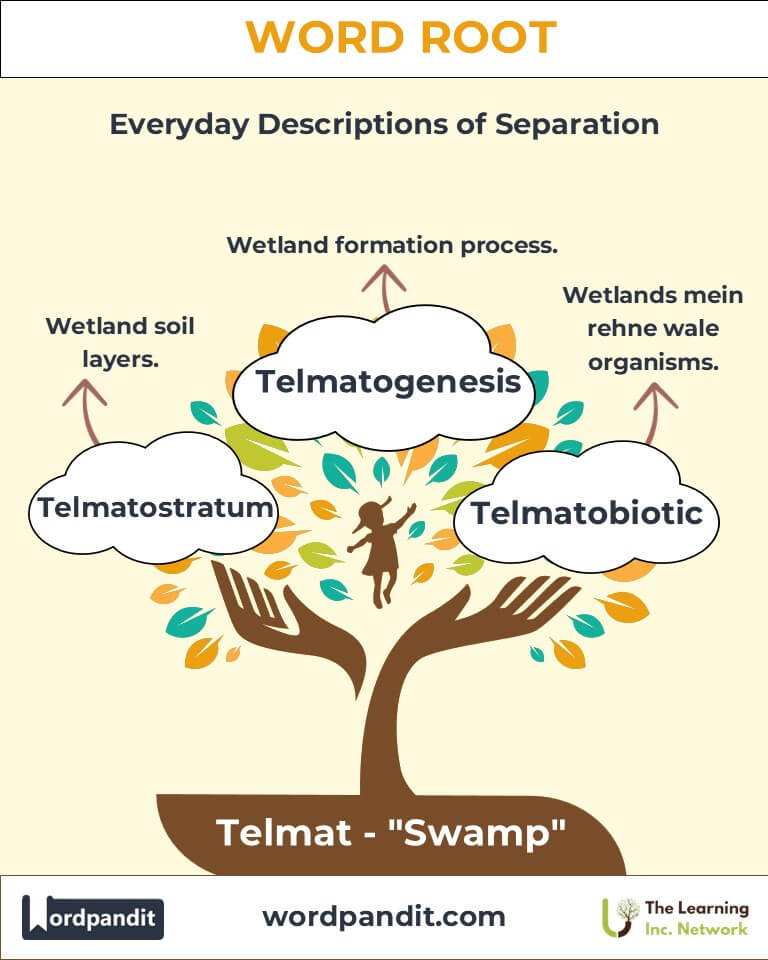Telmat: Exploring the Root of Wetlands and Ecology
Dive into the fascinating world of the word root "Telmat," derived from Greek, meaning "pond" or "wetland." This root lays the foundation for specialized terms in ecology and environmental science, offering insights into the unique ecosystems that thrive in wetlands.

Table of Contents
- Introduction: The Essence of Telmat
- Etymology and Historical Journey
- Mnemonic: Unlocking the Power of Telmat
- Common Telmat-Related Termat
- Telmat Through Time
- Telmat in Specialized Fields
- Illustrative Story: Telmat in Action
- Cultural Significance of Telmat
- The Telmat Family Tree
- FAQs about the Telmat Word Root
- Test Your Knowledge: Telmat Word Root Quiz
- Conclusion: The Living Legacy of Telmat
1. Introduction: The Essence of Telmat
The root "Telmat" (pronounced TEL-mat) originates from Greek and translates to "pond" or "wetland." It forms the basis of terms like telmatology and telmatic, which delve into the study and attributes of wetland ecosystems. These ecosystems, essential to biodiversity and water regulation, reflect the importance of this root in environmental discourse.

2. Etymology and Historical Journey
Telmat finds its roots in the Greek word telma, meaning "pond." Historically, wetlands were overlooked in many cultures, seen as wastelands or sources of disease. However, as ecological awareness grew, words rooted in telma gained prominence, aligning with efforts to preserve these vital ecosystems. This root anchors the study of wetlands in scientific disciplines, emphasizing their ecological and cultural significance.
3. Mnemonic: Unlocking the Power of Telmat
Picture a serene pond surrounded by reeds and vibrant wildlife, symbolizing the essence of "Telmat." Here's a mnemonic to help:
Mnemonic Device: "Telmat tells the story of ponds and wetlands, where life thrives in water’s embrace."
4. Common Telmat-Related Terms
- Telmatology (tel-ma-TOL-uh-jee):
- Definition: The scientific study of wetlands.
- Example: "Her thesis on telmatology highlighted the critical role of marshlands in flood control."
- Telmatic (tel-MAT-ik):
- Definition: Pertaining to or characteristic of wetlands.
- Example: "The telmatic vegetation indicated the presence of a thriving wetland ecosystem."
5. Telmat Through Time
- Ancient Views: Greek naturalists observed the diversity of life in ponds, but the term remained underexplored until the rise of ecology as a field.
- Modern Evolution: In the 20th century, telmatology emerged as a distinct discipline, focusing on wetland conservation.
6. Telmat in Specialized Fields
- Ecology:
- Terms like telmatology drive wetland preservation efforts.
- Environmental Science:
- Telmatic indicators help assess ecological health.
- Urban Planning:
- Understanding telmatic landscapes informs sustainable development in flood-prone areas.
7. Illustrative Story: Telmat in Action
Dr. Elena, a telmatologist, worked tirelessly to protect a local wetland threatened by urban expansion. By highlighting the wetland's telmatic plants and its role in preventing floods, she convinced policymakers to designate the area as a protected reserve. Her efforts underscored how "Telmat" preserves both life and landscape.
8. Cultural Significance of Telmat
Wetlands, though once maligned, hold cultural and spiritual significance in many societies. From Greek myths of watery underworlds to Indigenous traditions revering marshes as sources of life, telmatic landscapes inspire reverence and storytelling.

9. The Telmat Family Tree
- Limno (lake):
- Example: Limnology – Study of freshwater bodies.
- Hydro (water):
- Example: Hydrology – Study of water in the environment.
- Marsh (wetland):
- Example: Marshland – Low-lying wetland areas.

10. FAQs About " Telmat "
Q: What does the root "Telmat" mean?
A: The root "Telmat" comes from the Greek word telma, meaning "pond" or "wetland." It refers to marshy or waterlogged areas essential for various ecosystems, supporting biodiversity, water filtration, and flood management.
Q: What is telmatology?
A: Telmatology is the scientific study of wetlands, including their structure, function, and ecological importance. This field examines the plants, animals, and microorganisms that thrive in wetlands and how these ecosystems contribute to global environmental health.
Q: How do telmatic landscapes benefit the environment?
A: Telmatic landscapes provide essential services like water filtration, flood prevention, and carbon storage. They are biodiversity hotspots, supporting rare and unique species, and play a critical role in mitigating climate change by storing large amounts of carbon in their soils.
Q: What is a telmatic indicator?
A: Telmatic indicators are specific plants, animals, or microorganisms that signal the ecological health of a wetland. For example, cattails and certain species of frogs indicate a thriving wetland, while their absence might suggest environmental degradation.
Q: Are wetlands and ponds the same as telmatic areas?
A: While all ponds and wetlands can be considered telmatic, the term emphasizes the ecological and scientific significance of these habitats, particularly in terms of their soil, vegetation, and role in supporting ecosystems.
11. Test Your Knowledge: " Telmat " Mastery Quiz
1. What does the root "Telmat" signify?
2. What is telmatology?
3. What does telmatic vegetation indicate?
4. Which field of study examines telmatic landscapes?
5. What role do telmatic ecosystems play in the environment?
12. Conclusion: The Living Legacy of Telmat
The root "Telmat" connects language with the ecological significance of wetlands. From telmatology to telmatic studies, this root reminds us of the vital role these habitats play in sustaining life. As we face environmental challenges, let "Telmat" inspire efforts to protect the world's wetlands and their inherent beauty.












